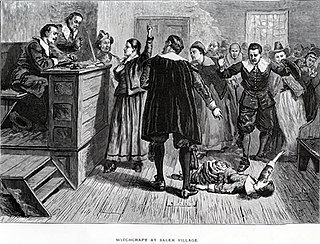
The Salem witch trials were a series of hearings and prosecutions of people accused of witchcraft in colonial Massachusetts between February 1692 and May 1693. More than 200 people were accused. Thirty people were found guilty, nineteen of whom were executed by hanging. One other man, Giles Corey, died under torture after refusing to enter a plea, and at least five people died in the disease-ridden jails.
John Proctor was a landowner in the Massachusetts Bay Colony. He and his wife Elizabeth were tried and convicted of witchcraft as part of the Salem Witch Trials, whereupon he was hanged.
Elizabeth Proctor was convicted of witchcraft in the Salem Witch Trials of 1692. She was the wife of John Proctor, who was convicted and executed.

Bridget Bishop was the first person executed for witchcraft during the Salem witch trials in 1692. Nineteen were hanged, and one, Giles Corey, was pressed to death. Altogether, about 200 people were tried.

Sarah Good was one of the first three women to be accused of witchcraft in the Salem witch trials, which occurred in 1692 in colonial Massachusetts.

Martha Corey was accused and convicted of witchcraft during the Salem witch trials, on September 9, 1692, and was hanged on September 22, 1692. Her second husband, Giles Corey, was also accused and killed.
Ann Foster was an Andover widow accused of witchcraft during the Salem witch trials.

Mercy Lewis was an accuser during the Salem Witch Trials. She was born in Falmouth, Maine. Mercy Lewis, formally known as Mercy Allen, was the child of Philip Lewis and Mary (Cass) Lewis.

Susannah Martin was one of fourteen women executed for the suspicion of practicing witchcraft during the Salem witch trials of colonial Massachusetts.

Ann Pudeator was a wealthy septuagenarian widow who was accused of and convicted of witchcraft in the Salem witch trials in colonial Massachusetts. She was executed by hanging.
This timeline of the Salem witch trials is a quick overview of the events.
Mary Parker of Andover, Massachusetts Bay Colony, the daughter of John Ayer, was executed by hanging on September 22, 1692, with several others, for witchcraft in the Salem witch trials. She was a 56 year old widow. It is believed that Mary Parker’s family buried her body on their property, as was tradition for those who were executed. Mary's husband, Nathan, died in 1685. Nicholas Noyes officiated. Her daughter, Sarah Parker, was also accused. Historians have identified three others persons named Mary Parker who lived in colonial Massachusetts at the same time who are sometimes conflated with the woman who was executed.
Mary Towne Eastey was a defendant in the Salem witch trials in colonial Massachusetts. She was executed by hanging in Salem in 1692.
Mary Bradbury was tried, convicted and sentenced to hang as a witch in Salem, Massachusetts in 1692. However, she managed to avoid her sentence until the trials had been discredited, and died in 1700, aged 85.
Elizabeth Howe was one of the accused in the Salem witch trials. She was found guilty and executed on July 19, 1692.

Sarah Bibber was involved in the infamous Salem witch trials in 1692, both as an accuser of witchcraft, as well as being accused of being a witch herself.
Deliverance Dane was one of many women accused of witchcraft during the Salem Witch Trials. She was the daughter of Robert and Anna Hazeltine. Dane was from Andover, Massachusetts, and due largely to the work of her father-in-law, much of the hysteria that swept through Salem was halted in Andover.
Stephen Nissenbaum, is an American scholar, a Professor Emeritus of the University of Massachusetts at Amherst's History Department specializing in early American history through to the nineteenth century. Most notably, he co-authored a book with Paul Boyer in 1974 about the Salem witch trials, Salem Possessed: The Social Origins of Witchcraft, called "a landmark in early American studies" by John Putnam Demos.

Martha Carrier was a Puritan accused and convicted of being a witch during the 1692 Salem witch trials.









